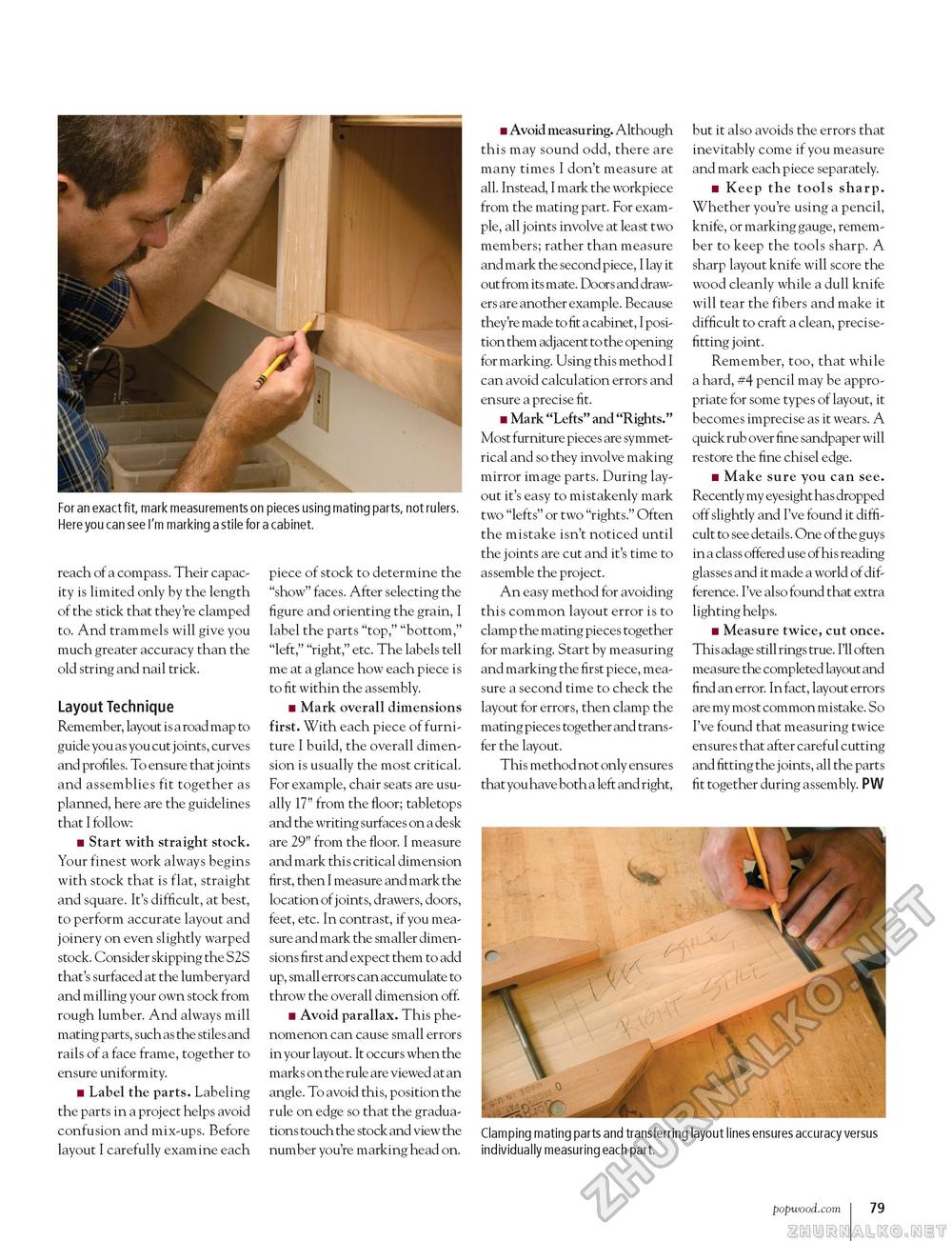Popular Woodworking 2005-04 № 147, страница 82
For an exact fit, mark measurements on pieces using mating parts, not rulers. Here you can see I'm marking a stile for a cabinet. reach of a compass. Their capacity is limited only by the length of the stick that they're clamped to. And trammels will give you much greater accuracy than the old string and nail trick. Layout Technique Remember, layout is a road map to guide you as you cut joints, curves and profile s. To ensure that joints and assemblies fit together as planned, here are the guidelines that I follow: ■ Start with straight stock. Your finest work always begins with stock that is flat, straight and square. It's difficult, at best, to perform accurate layout and joinery on even slightly warped stock. Consider skipping the S2S that's surfaced at the lumberyard and milling your own stock from rough lumber. And always mill mating parts, such as the stiles and rails of a face frame, together to ensure uniformity. ■ Label the parts. Labeling the parts in a project helps avoid confusion and mix-ups. Before layout I carefully examine each piece of stock to determine the "show" faces. After selecting the figure and orienting the grain, I label the parts "top," "bottom," "left," "right," etc. The labels tell me at a glance how each piece is to fit within the assembly. ■ Mark overall dimensions first. With each piece of furniture I build, the overall dimension is usually the most critical. For example, chair seats are usually 17" from the floor; tabletops and the writing surfaces on a desk are 29" from the floor. I measure and mark this critical dimension first, then I measure and mark the location of joints, drawers, doors, feet, etc. In contrast, if you measure and mark the smaller dimensions first and expect them to add up, small errors can accumulate to throw the overall dimension off. ■ Avoid parallax. This phenomenon can cause small errors in your layout. It occurs when the marks on the rule are viewed at an angle. To avoid this, position the rule on edge so that the graduations touch the stock and view the number you're marking head on. ■ Avoid measuring. Although this may sound odd, there are many times I don't measure at all. Instead, I mark the workpiece from the mating part. For example, all joints involve at least two members; rather than measure and mark the second piece, I lay it out from its mate. Doors and drawers are another example. Because they're made to fit a cabinet, I position them adjacent to the opening for marking. Using this method I can avoid calculation errors and ensure a precise fit. ■ Mark "Lefts" and "Rights." Most furniture pieces are symmetrical and so they involve making mirror image parts. During layout it's easy to mistakenly mark two "lefts" or two "rights." Often the mistake isn't noticed until the joints are cut and it's time to assemble the project. An easy method for avoiding this common layout error is to clamp the mating pieces together for marking. Start by measuring and marking the first piece, measure a second time to check the layout for errors, then clamp the mating pieces together and transfer the layout. This method not only ensures that you have both a left and right, r \ but it also avoids the errors that inevitably come if you measure and mark each piece separately. ■ Keep the tools sharp. Whether you're using a pencil, knife, or marking gauge, remember to keep the tools sharp. A sharp layout knife will score the wood cleanly while a dull knife will tear the fibers and make it difficult to craft a clean, precise-fitting joint. Remember, too, that while a hard, #4 pencil may be appropriate for some types of layout, it becomes imprecise as it wears. A quick rub over fine sandpaper will restore the fine chisel edge. ■ Make sure you can see. Recently my eyesight has dropped off slightly and I've found it difficult to see details. One of the guys in a class offered use of his reading glasses and it made a world of difference. I've also found that extra lighting helps. ■ Measure twice, cut once. This adage still rings true. I'll often measure the completed layout and find an error. In fact, layout errors are my most common mistake. So I've found that measuring twice ensures that after careful cutting and fitting the joints, all the parts fit together during assembly. PW Clamping mating parts and transferring layout lines ensures accuracy versus individually measuring each part. popwood.com 79 |








